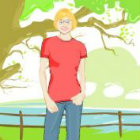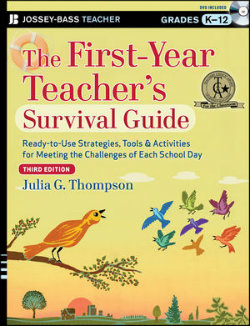Another Look at The First-Year Teacher’s Survival Guide
The First-Year Teacher’s Survival Guide: Ready-to-Use Strategies, Tools & Activities for Meeting the Challenges of Each School Day
By Julia G. Thompson
(Jossey-Bass Teacher, 2013 – Learn more)

The First-Year Teacher’s Survival Guide by Julia G. Thompson is a large book filled with tips on most of the processes and procedures that a teacher may run into in his or her career. The book is clearly divided into sections that cover the major areas of teaching: assuming professional responsibilities, establishing a learning community, promoting achievement, designing instruction, and maintaining order.
Due to the size of this book, it has a secondary table of contents that then breaks down each major section into specific topics. It has lists, checklists, self-evaluations, and suggestions for nearly every problem that a teacher can imagine. This book also comes with a DVD that includes all of the checklists and forms that are included in the book. A list of these can be found on a DVD table of contents in the front of the book. The DVD also contains some bonus sections that were not included in the book.
A reference, not a quick read
This book is enormous in size and scope. When I first picked it up, I was very intimidated by it. As a first-year teacher my workload is huge, and adding a huge book didn’t seem like such a great idea. I began to flip through it and found that I was folding down a number of pages. What I quickly learned is that The First-Year Teacher’s Survival Guide is most useful when it is treated like a reference book rather than a professional book that you sit down and read cover to cover.
If you need a “before they read” activity, you can find a list on page 419. Maybe you need a list of strategies for the differentiated classroom. It is on pages 342-345. Perhaps you need a self-evaluation about how appropriate you are in your relationships with students. You can go through that checklist on page 142. If you have a problem and can remember to grab this book, your problem is likely addressed somewhere inside the covers.
This book would have made a wonderful textbook that could have been used in almost all of my teacher education courses. In fact, it has more useful information that my middle grades textbook had. Rather than having case studies and vignettes, this book has ideas and lists.
I love the list aspect. Scanning bullet points is much easier than reading a case study and then trying to pull out the methods that may apply to me. I can quickly scan the list, think about the content, fold down the page if it’s potentially useful, and then use the point(s) that fit my needs the best. The checklist and bullet point style makes this a great toolbox as you can scan it and get what you need without committing yourself to large chunks of time.
So, the scope of this book can be useful. But may also be a hindrance. While you can look up nearly any topic and have a list, checklist, evaluation, or article, will you remember to dive into this book? Finding answers might be easier if the massive amounts of information were organized into shorter, topical books. I find myself more likely to grab a book on assessing students than to dig through this book to find the answer.
While the headings and double table of contents lists are helpful, the index is abysmal. Rather than separating out the topics under the headings, it uses semicolons. It also groups some items under headings and then other items by themselves. If the publisher is going to offer such a mammoth book, there should be a fabulous index to go with it.
My recommendation
This book would be useful to have as a “teacher encyclopedia” in case you ever need some ideas or checklists. If you are looking for a book to sit down and read to understand your role as a new teacher, then this book is likely too overwhelming to do the job well.
_____
For another take on The First-Year Teacher’s Survival Guide, read our review by teacher educator Amanda Wall.
_____
Lena Welch teaches seventh grade science in Columbus, Ohio at an online K-12 charter school. When she isn’t teaching, she loves to read, writes articles for HubPages, manages The Clot Spot, a website for pulmonary embolism survivors, and volunteers at a local science museum. Lena loves to learn and has gathered a number of college degrees and certifications including a Bachelor of Psychology, Masters of Occupational Therapy, and middle grades science and language arts teaching certification.































